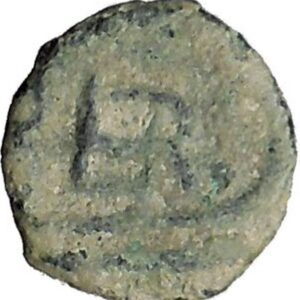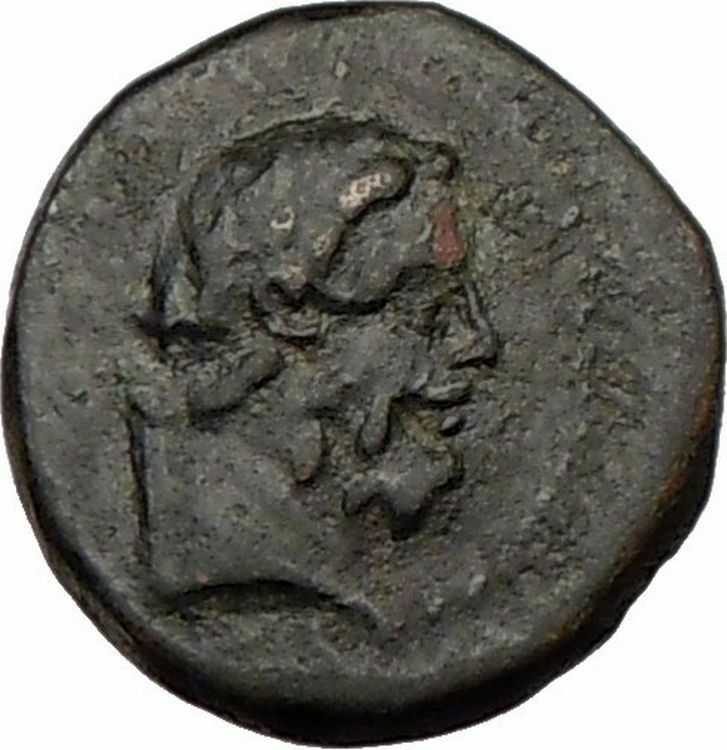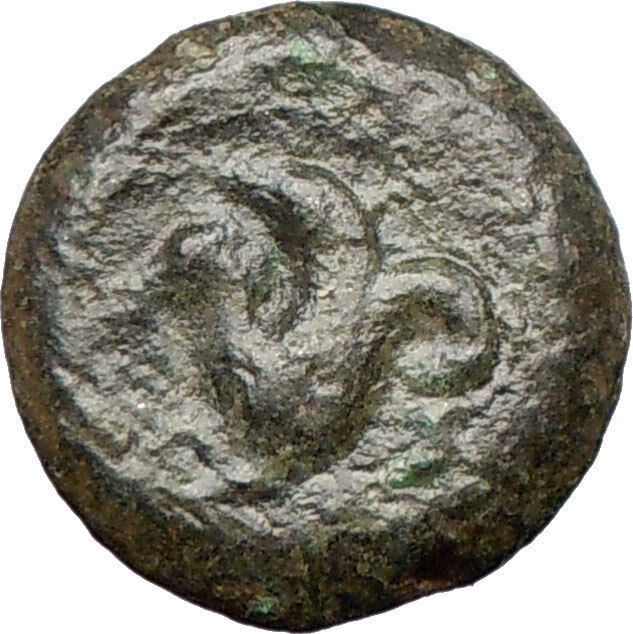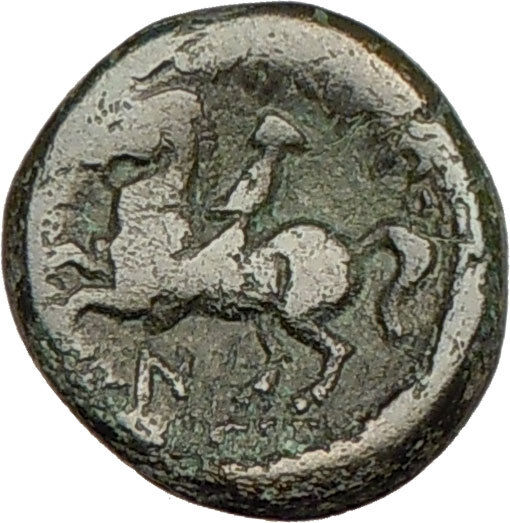|
Greek Coin of Seleukid Kingdom
Antiochos VII Sidetes – King: 138-129 B.C.
Bronze 15mm Antioch on the Orontes mint, struck circa 138-129 B.C.
Reference: HGC 9, 1096; Sear 7100
Certification: NGC Ancients VG 4285281-114
Nemean lion’s head right.
Club of Hercules; on right, ΒΑΣΙΛΕΩΣ / ANTIOXOY; on left, EYEPΓETOY.
Almost alone amongst the later Seleukid monarchs, Antiochos VII ruled with competence and integrity. He was the younger brother of Demetrios II, and following the latter’s capture by the Parthians he seized power and quickly disposed the usurper Tryphon. He campaigned with success in Palestine and Babylonia, but in 129 B.C. he was killed in battle against the Parthians.
You are bidding on the exact item pictured, provided with a Certificate of Authenticity and Lifetime Guarantee of Authenticity.
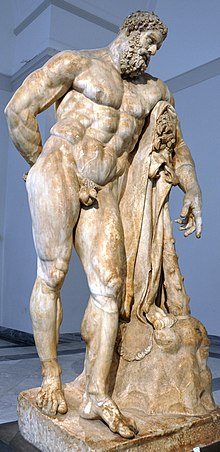 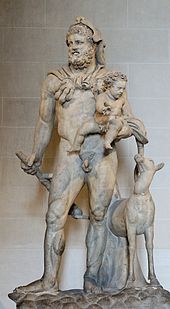 Heracles, born Alcaeus (Alkaios) or Alcides, was a divine hero in Greek mythology, the son of Zeus and Alcmene, foster son of Amphitryon and great-grandson and half-brother (as they are both sired by the god Zeus) of Perseus. He was the greatest of the Greek heroes, a paragon of masculinity, the ancestor of royal clans who claimed to be Heracleidae and a champion of the Olympian order against chthonic monsters. In Rome and the modern West, he is known as Hercules, with whom the later Roman emperors, in particular Commodus and Maximian, often identified themselves. The Romans adopted the Greek version of his life and works essentially unchanged, but added anecdotal detail of their own, some of it linking the hero with the geography of the Central Mediterranean. Details of his cult were adapted to Rome as well. Heracles, born Alcaeus (Alkaios) or Alcides, was a divine hero in Greek mythology, the son of Zeus and Alcmene, foster son of Amphitryon and great-grandson and half-brother (as they are both sired by the god Zeus) of Perseus. He was the greatest of the Greek heroes, a paragon of masculinity, the ancestor of royal clans who claimed to be Heracleidae and a champion of the Olympian order against chthonic monsters. In Rome and the modern West, he is known as Hercules, with whom the later Roman emperors, in particular Commodus and Maximian, often identified themselves. The Romans adopted the Greek version of his life and works essentially unchanged, but added anecdotal detail of their own, some of it linking the hero with the geography of the Central Mediterranean. Details of his cult were adapted to Rome as well.
Extraordinary strength, courage, ingenuity, and sexual prowess with both males and females were among the characteristics commonly attributed to him. Heracles used his wits on several occasions when his strength did not suffice, such as when laboring for the king Augeas of Elis, wrestling the giant Antaeus, or tricking Atlas into taking the sky back onto his shoulders. Together with Hermes he was the patron and protector of gymnasia and palaestrae. His iconographic attributes are the lion skin and the club. These qualities did not prevent him from being regarded as a playful figure who used games to relax from his labors and played a great deal with children. By conquering dangerous archaic forces he is said to have “made the world safe for mankind” and to be its benefactor. Heracles was an extremely passionate and emotional individual, capable of doing both great deeds for his friends (such as wrestling with Thanatos on behalf of Prince Admetus, who had regaled Heracles with his hospitality, or restoring his friend Tyndareus to the throne of Sparta after he was overthrown) and being a terrible enemy who would wreak horrible vengeance on those who crossed him, as Augeas, Neleus and Laomedon all found out to their cost.
 The Nemean lion (Latin: Leo Nemeaeus) was a vicious monster in Greek mythology that lived at Nemea. It was eventually killed by Heracles. It could not be killed with mortals’ weapons because its golden fur was impervious to attack. Its claws were sharper than mortals’ swords and could cut through any armor. The Nemean lion (Latin: Leo Nemeaeus) was a vicious monster in Greek mythology that lived at Nemea. It was eventually killed by Heracles. It could not be killed with mortals’ weapons because its golden fur was impervious to attack. Its claws were sharper than mortals’ swords and could cut through any armor.
Today, lions are not part of the Greek fauna (or the fauna of Europe). However, according to Herodotus, lion populations were extant in Ancient Greece, until around 100 BC when they became extinct.
The lion is usually considered to have been the offspring of Typhon (or Orthrus) and Echidna; it is also said to have fallen from the moon as the offspring of Zeus and Selene, or alternatively born of the Chimera. The Nemean lion was sent to Nemea in the Peloponnesus to terrorize the city.
Nemean Lion as the Leo Astrological Symbol
Leo is one of the constellations of the zodiac, lying between Cancer the crab to the west and Virgo the maiden to the east. Its name is Latin for lion, and to the ancient Greeks represented the Nemean Lion killed by the mythical Greek hero Heracles (known to the ancient Romans as Hercules) as one of his twelve labors. Its symbol is  (Unicode ♌). One of the 48 constellations described by the 2nd-century astronomer Ptolemy, Leo remains one of the 88 modern constellations today, and one of the most easily recognizable due to its many bright stars and a distinctive shape that is reminiscent of the crouching lion it depicts. The lion’s mane and shoulders also form an asterism known as “The Sickle,” which to modern observers may resemble a backwards “question mark.” (Unicode ♌). One of the 48 constellations described by the 2nd-century astronomer Ptolemy, Leo remains one of the 88 modern constellations today, and one of the most easily recognizable due to its many bright stars and a distinctive shape that is reminiscent of the crouching lion it depicts. The lion’s mane and shoulders also form an asterism known as “The Sickle,” which to modern observers may resemble a backwards “question mark.”
 First labour of Heracles First labour of Heracles
The first of Heracles’ twelve labours, set by King Eurystheus (his cousin) was to slay the Nemean lion.
According to one version of the myth, the Nemean lion took women as hostages to its lair in a cave near Nemea, luring warriors from nearby towns to save the damsel in distress. After entering the cave, the warrior would see a woman (usually feigning injury) and rush to her side. Once he was close, the woman would turn into a lion and kill the warrior, devouring his remains and giving the bones to Hades.
Heracles wandered the area until he came to the town of Cleonae. There he met a boy who said that if Heracles slew the Nemean lion and returned alive within 30 days, the town would sacrifice a lion to Zeus; but if he did not return within 30 days or he died, the boy would sacrifice himself to Zeus. Another version claims that he met Molorchos, a shepherd who had lost his son to the lion, saying that if he came back within 30 days, a ram would be sacrificed to Zeus. If he did not return within 30 days, it would be sacrificed to the dead Heracles as a mourning offering.
While searching for the lion, Heracles fetched some arrows to use against it, not knowing that its golden fur was impenetrable; when he found the lion and shot at it with his bow, he discovered the fur’s protective property when the arrow bounced harmlessly off the creature’s thigh. After some time, Heracles made the lion return to his cave. The cave had two entrances, one of which Heracles blocked; he then entered the other. In those dark and close quarters, Heracles stunned the beast with his club and, using his immense strength, strangled it to death. During the fight the lion bit off one of his fingers. Others say that he shot arrows at it, eventually shooting it in the unarmoured mouth.
After slaying the lion, he tried to skin it with a knife from his belt, but failed. He then tried sharpening the knife with a stone and even tried with the stone itself. Finally, Athena, noticing the hero’s plight, told Heracles to use one of the lion’s own claws to skin the pelt.
When he returned on the thirtieth day carrying the carcass of the lion on his shoulders, King Eurystheus was amazed and terrified. Eurystheus forbade him ever again to enter the city; in future he was to display the fruits of his labours outside the city gates. Eurystheus warned him that the tasks set for him would become increasingly difficult. He then sent Heracles off to complete his next quest, which was to destroy the Lernaean hydra.
The Nemean lion’s coat was impervious to the elements and all but the most powerful weapons. Others say that Heracles’ armour was, in fact, the hide of the lion of Cithaeron.
According to some authors, Heracles was helped in this labour by an Earth-born serpent, which followed him to Thebes and settled down in Aulis. It was later identified as the water snake which devoured the sparrows and was turned into stone in the prophecy about the Trojan War.
Antiochus VII Euergetes, nicknamed Sidetes (from Side), ruler of the Hellenistic Seleucid Empire, reigned from 138 to 129 BC. He was the last Seleucid king of any stature.
Biography
He was one of the sons of Demetrius I Soter, the brother of Demetrius II Nicator and his mother may have been Laodice V. Antiochus was elevated after Demetrius’ capture by the Parthians. He married Cleopatra Thea, who had been the wife of Demetrius. Their offspring was Antiochus IX, who thus became both half-brother and cousin to Seleucus V and Antiochus VIII.
Sidetes defeated the usurper Tryphon at Dora and laid siege to Jerusalem in 132. During the siege he allowed a seven day truce for the Jews to celebrate a religious festival, impressing the Jewish leadership. According to Josephus the Hasmonean leader John Hyrcanus opened King David’s sepulchre and removed three thousand talents, which he then paid Antiochus to spare the city. Nevertheless, King Antiochus’ respectful treatment of the Jews, and respect for their religion, earned him their gratitude and added name, Euergetes (“the Benefactor”). With no Jewish sources of that time (the Book of Maccabees ends few years before his time) it is unclear if the siege on Jerusalem ended with a decisive Seleucid victory or simply a peace treaty. Furthermore, the fact is that Jewish forces later assisted Sidetes in his wars, and that for nearly 20 years after his death, John Hyrcanus refrained of attacking areas under Seleucid control. All in all it indicates a renewal of the friendly relations from the time of Demetrius II.
Antiochus spent the final years of his life attempting to reclaim the lost eastern territories, overrun by the Parthians under their “Great King”, Mithridates I. Marching east, with what would prove to be the last great Seleucid royal army (including a unit of Judean troops under John Hyrcanus), he defeated Mithridates in two battles, killing the aged Parthian king in the last of these. He restored Mesopotamia, Babylonia and Media to the Seleucid empire, before dispersing his army into winter quarters.
The Seleucid king and army spent the winter feasting, hunting, and drinking (the Seleucids maintained the Macedonian tradition of heavy drinking). As with any time an army is quartered upon a population, tensions soon grew between the locals and the Seleukian troops.
The new Parthian ruler, Phraates II, had not been idle; raising a new army while stirring up rebellion in the Seleucid occupied towns of Media. Hoping to further sew dissension amongst his foe, Phraates also released his long-held prisoner, Demetrius II, Antiochus’ older brother, to return to Seleukia and reclaim the throne.
That winter (130-129 BCE), several Median towns rose in rebellion and attacked their Seleucid garrisons. Antiochus marched to support one such isolated garrison with only a small force (likely only his Royal Guards). In a barren valley, he was ambushed and killed by Phraates II and a large force of Parthians, which had entered the country without being detected. The last great Seleucid king died in battle, a fitting end for the heir of Seleucus I Nicator (the Victor). (One disputed account has Antiochus take his own life, after the battle is lost, to avoid capture by the Parthians.)
After Antiochus VII Sidetes, the Parthians regained the territory briefly lost, and the Seleucid realm was now restricted to Seleukia.
|










 Heracles, born Alcaeus (Alkaios) or Alcides, was a divine hero in Greek mythology, the son of Zeus and Alcmene, foster son of Amphitryon and great-grandson and half-brother (as they are both sired by the god Zeus) of Perseus. He was the greatest of the Greek heroes, a paragon of masculinity, the ancestor of royal clans who claimed to be Heracleidae and a champion of the Olympian order against chthonic monsters. In Rome and the modern West, he is known as Hercules, with whom the later Roman emperors, in particular Commodus and Maximian, often identified themselves. The Romans adopted the Greek version of his life and works essentially unchanged, but added anecdotal detail of their own, some of it linking the hero with the geography of the Central Mediterranean. Details of his cult were adapted to Rome as well.
Heracles, born Alcaeus (Alkaios) or Alcides, was a divine hero in Greek mythology, the son of Zeus and Alcmene, foster son of Amphitryon and great-grandson and half-brother (as they are both sired by the god Zeus) of Perseus. He was the greatest of the Greek heroes, a paragon of masculinity, the ancestor of royal clans who claimed to be Heracleidae and a champion of the Olympian order against chthonic monsters. In Rome and the modern West, he is known as Hercules, with whom the later Roman emperors, in particular Commodus and Maximian, often identified themselves. The Romans adopted the Greek version of his life and works essentially unchanged, but added anecdotal detail of their own, some of it linking the hero with the geography of the Central Mediterranean. Details of his cult were adapted to Rome as well. The Nemean lion (Latin: Leo Nemeaeus) was a vicious monster in Greek mythology that lived at Nemea. It was eventually killed by Heracles. It could not be killed with mortals’ weapons because its golden fur was impervious to attack. Its claws were sharper than mortals’ swords and could cut through any armor.
The Nemean lion (Latin: Leo Nemeaeus) was a vicious monster in Greek mythology that lived at Nemea. It was eventually killed by Heracles. It could not be killed with mortals’ weapons because its golden fur was impervious to attack. Its claws were sharper than mortals’ swords and could cut through any armor. (Unicode ♌). One of the 48 constellations described by the 2nd-century astronomer Ptolemy, Leo remains one of the 88 modern constellations today, and one of the most easily recognizable due to its many bright stars and a distinctive shape that is reminiscent of the crouching lion it depicts. The lion’s mane and shoulders also form an asterism known as “The Sickle,” which to modern observers may resemble a backwards “question mark.”
(Unicode ♌). One of the 48 constellations described by the 2nd-century astronomer Ptolemy, Leo remains one of the 88 modern constellations today, and one of the most easily recognizable due to its many bright stars and a distinctive shape that is reminiscent of the crouching lion it depicts. The lion’s mane and shoulders also form an asterism known as “The Sickle,” which to modern observers may resemble a backwards “question mark.” First labour of Heracles
First labour of Heracles

